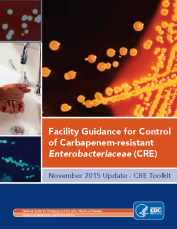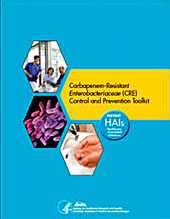Facility Guidance for Control of Carbapenem-resistant Enterobacteriaceae (CRE) – November 2015 Update CRE Toolkit
Carbapenem-resistant Enterobacteriaceae (CRE) are a serious threat to public health. Infections with CRE are difficult, and in some cases impossible, to treat and have been associated with mortality rates up to 50%(1). Due to the movement of patients throughout the healthcare system, if CRE are a problem in one facility, then typically they are a problem in other facilities in the region as well. To help protect patients and prevent transmission, CDC has updated 2012 CRE toolkit; this document will continue to be updated as new information becomes available.

This document is intended for state and local health departments and healthcare facilities and serves as general or resistance mechanisms. It is not intended to describe all the actions that might be required for control of an outbreak (e.g., sustained transmission within a facility or region). In addition, further evaluation might be required based on the findings of the initial response described in this document.
Print version: Interim Guidance for a Health Response to Contain Novel or Targeted MDROs [PDF – 10 pages]
- Page last reviewed: March 1, 2013
- Page last updated: April 18, 2017
- Content source:


 ShareCompartir
ShareCompartir


